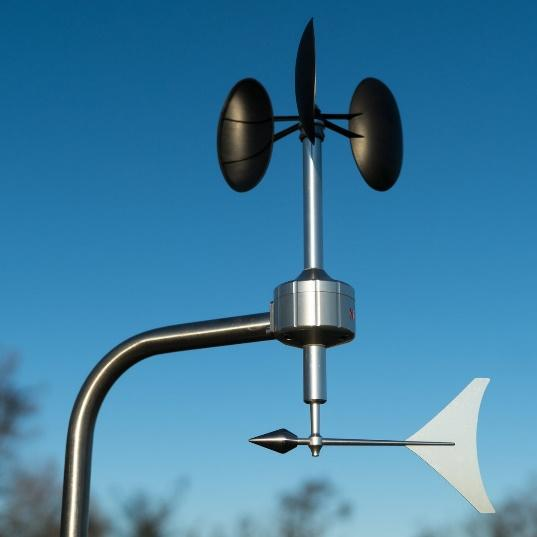
Anemometer is used to measure_____.
A.Wind speed
B.Distance
C.Area
D.Water speed
Answer
523.5k+ views
Hint: Anemometer is used to monitor change in weather. It is used by long range shooters and pilots too. It was developed in 1450. Since then, many scientists developed their own version of anemometer but there has been no change in the fundamental design of this device, it remained the same. It is used by physicists as well as meteorologists in their respective fields. These are used at all weather stations from the Arctic to warm equatorial regions.
Complete answer:

The first known description of an Anemometer was given by Leon Battista Alberti in 1450. Anemometer is an instrument used to monitor weather. It is used for wind speed. It measures pressure and force of wind. We can also say that it can also measure wind direction. The unit of measurement of an anemometer is feet per minute, or FPM. These rotations are sensed by a magnetic or optical sensor. These sensors convert the signal to FPM measurement.
Anemometers are used at airports, weather stations etc. This instrument is generally attached to a weather vane to detect wind direction. It is an important tool for meteorologists to study patterns in weather. It is also important for physics to study air flow.
Most commonly used is Cup anemometers. It electronically measures the wind by counting revolutions per minute. Few other types are Laser anemometers, hotwire anemometers etc.
Majority of cup anemometers are meant to be mounted on either a building or a sailboat but there are few anemometers which are handheld. Wind speed depends on local geography as well such as hills, houses, trees etc. These things funnel the wind and thus the variation is seen in wind speed.
So, the correct answer is option A.
Note:
The handheld anemometers have cups which start spinning as wind flows and when the wind flows, vane aligns with wind. There's a dial on an anemometer to measure wind direction. Wind speed is displayed on the LCD display. The whole instrument is fixed in an aluminium case. Wind speed by showing the change in the weather patterns, such as wind storms, which is important for pilots, climatologists, etc.
Complete answer:

The first known description of an Anemometer was given by Leon Battista Alberti in 1450. Anemometer is an instrument used to monitor weather. It is used for wind speed. It measures pressure and force of wind. We can also say that it can also measure wind direction. The unit of measurement of an anemometer is feet per minute, or FPM. These rotations are sensed by a magnetic or optical sensor. These sensors convert the signal to FPM measurement.
Anemometers are used at airports, weather stations etc. This instrument is generally attached to a weather vane to detect wind direction. It is an important tool for meteorologists to study patterns in weather. It is also important for physics to study air flow.
Most commonly used is Cup anemometers. It electronically measures the wind by counting revolutions per minute. Few other types are Laser anemometers, hotwire anemometers etc.
Majority of cup anemometers are meant to be mounted on either a building or a sailboat but there are few anemometers which are handheld. Wind speed depends on local geography as well such as hills, houses, trees etc. These things funnel the wind and thus the variation is seen in wind speed.
So, the correct answer is option A.
Note:
The handheld anemometers have cups which start spinning as wind flows and when the wind flows, vane aligns with wind. There's a dial on an anemometer to measure wind direction. Wind speed is displayed on the LCD display. The whole instrument is fixed in an aluminium case. Wind speed by showing the change in the weather patterns, such as wind storms, which is important for pilots, climatologists, etc.
Recently Updated Pages
Master Class 11 Economics: Engaging Questions & Answers for Success

Master Class 11 Accountancy: Engaging Questions & Answers for Success

Master Class 11 English: Engaging Questions & Answers for Success

Master Class 11 Social Science: Engaging Questions & Answers for Success

Master Class 11 Biology: Engaging Questions & Answers for Success

Master Class 11 Physics: Engaging Questions & Answers for Success

Trending doubts
1 ton equals to A 100 kg B 1000 kg C 10 kg D 10000 class 11 physics CBSE

Difference Between Prokaryotic Cells and Eukaryotic Cells

One Metric ton is equal to kg A 10000 B 1000 C 100 class 11 physics CBSE

1 Quintal is equal to a 110 kg b 10 kg c 100kg d 1000 class 11 physics CBSE

Draw a diagram of nephron and explain its structur class 11 biology CBSE

Explain zero factorial class 11 maths CBSE




